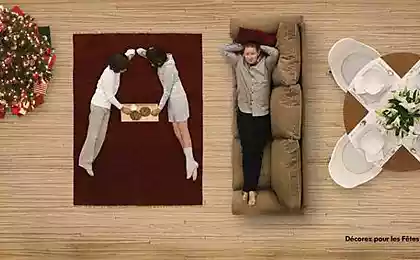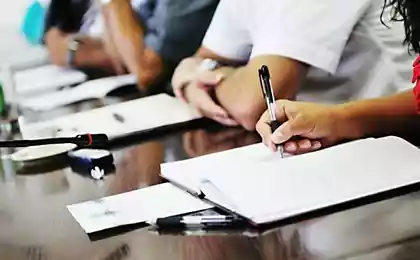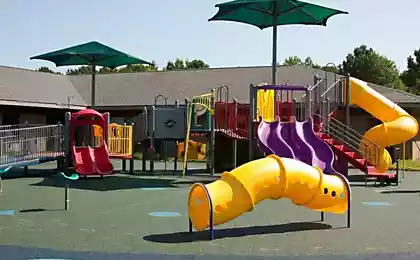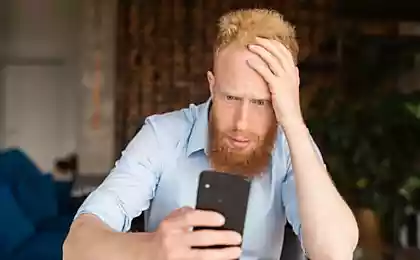560
Deadly crumbs (5 photo + letter)
A small post about the animal world, which are extremely dangerous to humans, and thus are free to fit in your pocket.
The good news - they are found in a variety of exotic locations, so that the average townspeople meet with such little animals is almost impossible.
Golden poison frog (Phyllobates terribilis)
If you are going on a journey through the jungle of Colombia, you can find this tiny creature measuring less than three centimeters and weighs a few grams. Do not try to touch her hands or strongly regret it! If you do not skip school biology, you know that the bright colors in nature are usually warns against the risk of its owner, and gold frog - a direct confirmation of this. On the surface of her skin is so powerful poison that it is enough to kill a dozen healthy adult males. It's enough just to touch the frog. The natives used its venom to cover the tips of arrows, just "rubbing" of their freshly caught a frog.
How did such a small amphibian much venom? Scientists believe that the frog's body processes the food that she eats, allocating and concentrating the toxins out of it, which in the end are displayed on the surface of the skin glands. We can only guess what this stuff is eating a frog ... In this scientific poison called crumbs batrachotoxin ("batraho" - frog in Greek), and operates mainly in the cardiovascular system and nervous system (or any other animal). In nature, there is only one animal that is not afraid of this deadly frogs and even eats them - a snake species leimadophis epinephelus. To help you become even worse with kazhu that this frog poison fifteen times stronger than curare poison and an antidote to it does not currently exist.

The cone-shaped snail (Conus geographus)
Colombia will head somewhere far away, in Australia, for example. In the waters around the Great Barrier Reef is found a lot of different animals, all bright and colorful ... Among them are lurking unseen brown snail with a beautiful shell. You reach out to pick up the sink and take a closer look, and suddenly feel a prick. Congratulations, you are introduced to one of the most poisonous species in Australia!
Prick who feels man tried to grab the cochlea, caused by the bite of a poisonous tooth that "injects" into the body of the victim cocktail of hundreds of toxins that are beginning to work together, causing very unpleasant sensations, including "strong salivation, sweating, headache, weakness , lethargy, ataxia, tremors, paralysis, cyanosis, loss of voice, difficulty swallowing, seizures, wet cough, respiratory failure, low blood pressure and coma. " A good set, is not it? Furthermore, in addition stung experiencing severe nausea, vomiting, diarrhea and abdominal pain. An antidote to the bite of the snail does not exist - only that in this case, do the doctors, it supports the patient's life, entering into the blood nutrient solutions and reduce the dehydration (water loss) in the body, while the patient gets rid of toxins, using all available paths ...

As you know, everyone in the world has at least two "sides" - positive and negative, and poisonous snail too. As a result of research, scientists have determined that the toxins that make up the snail venom, after special processing are transformed into a set of proteins that act as super-strong painkiller - 10,000 times stronger and more effective than morphine, but without the side effects that accompany it.

Blue-ringed octopus (Hapalochlaena lunulata)
After becoming acquainted with such a dangerous snail you decide not to swim deep and wander through the shallow water, looking at the bright shells. Among them, you will notice a small bright Osmino, which is clearly seen a lot of blue rings. Since about biology at this time you do not think it carefully pick it up, examining all sides. And again, you're out of luck - it's poisonous octopus, which bites you quickly with its beak, injecting venom. How can you determine that the poison acts? It's very simple - try to move. You do not succeed - a mixture of ten toxin paralyzes the body, and you still do not feel anything and you can not move. After some time, due to the cessation of breathing person begins to feel a lot of pain, while continuing to be aware of everything that is happening around. Fish, octopus are bitten by this, not to be envied - it just eats them paralyzed, alive. Poison one small octopus will be enough to immobilize and kill thirty people.
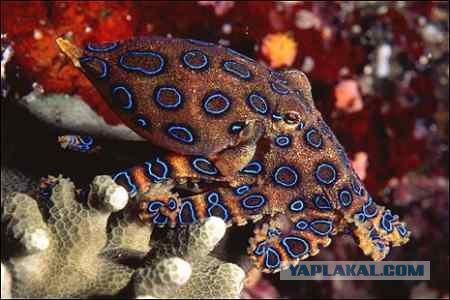
The venom from this octopus develop special bacteria in the bubbles on the surface of the skin, and the bite of octopus so the main difficulty for the victim - send a signal that something is not right. Outsiders just do not see - the man stopped and everyone knows what he is considering? Or just fainted. If by good fortune with you there were people, and they saw that you were bitten by just such an octopus, the main treatment in this case - an artificial lung ventilyaschiya until the person begins to breathe on their own, which will take several hours. One day he will poison the body.
via mindhobby.com

Source:
The good news - they are found in a variety of exotic locations, so that the average townspeople meet with such little animals is almost impossible.
Golden poison frog (Phyllobates terribilis)
If you are going on a journey through the jungle of Colombia, you can find this tiny creature measuring less than three centimeters and weighs a few grams. Do not try to touch her hands or strongly regret it! If you do not skip school biology, you know that the bright colors in nature are usually warns against the risk of its owner, and gold frog - a direct confirmation of this. On the surface of her skin is so powerful poison that it is enough to kill a dozen healthy adult males. It's enough just to touch the frog. The natives used its venom to cover the tips of arrows, just "rubbing" of their freshly caught a frog.
How did such a small amphibian much venom? Scientists believe that the frog's body processes the food that she eats, allocating and concentrating the toxins out of it, which in the end are displayed on the surface of the skin glands. We can only guess what this stuff is eating a frog ... In this scientific poison called crumbs batrachotoxin ("batraho" - frog in Greek), and operates mainly in the cardiovascular system and nervous system (or any other animal). In nature, there is only one animal that is not afraid of this deadly frogs and even eats them - a snake species leimadophis epinephelus. To help you become even worse with kazhu that this frog poison fifteen times stronger than curare poison and an antidote to it does not currently exist.

The cone-shaped snail (Conus geographus)
Colombia will head somewhere far away, in Australia, for example. In the waters around the Great Barrier Reef is found a lot of different animals, all bright and colorful ... Among them are lurking unseen brown snail with a beautiful shell. You reach out to pick up the sink and take a closer look, and suddenly feel a prick. Congratulations, you are introduced to one of the most poisonous species in Australia!
Prick who feels man tried to grab the cochlea, caused by the bite of a poisonous tooth that "injects" into the body of the victim cocktail of hundreds of toxins that are beginning to work together, causing very unpleasant sensations, including "strong salivation, sweating, headache, weakness , lethargy, ataxia, tremors, paralysis, cyanosis, loss of voice, difficulty swallowing, seizures, wet cough, respiratory failure, low blood pressure and coma. " A good set, is not it? Furthermore, in addition stung experiencing severe nausea, vomiting, diarrhea and abdominal pain. An antidote to the bite of the snail does not exist - only that in this case, do the doctors, it supports the patient's life, entering into the blood nutrient solutions and reduce the dehydration (water loss) in the body, while the patient gets rid of toxins, using all available paths ...

As you know, everyone in the world has at least two "sides" - positive and negative, and poisonous snail too. As a result of research, scientists have determined that the toxins that make up the snail venom, after special processing are transformed into a set of proteins that act as super-strong painkiller - 10,000 times stronger and more effective than morphine, but without the side effects that accompany it.

Blue-ringed octopus (Hapalochlaena lunulata)
After becoming acquainted with such a dangerous snail you decide not to swim deep and wander through the shallow water, looking at the bright shells. Among them, you will notice a small bright Osmino, which is clearly seen a lot of blue rings. Since about biology at this time you do not think it carefully pick it up, examining all sides. And again, you're out of luck - it's poisonous octopus, which bites you quickly with its beak, injecting venom. How can you determine that the poison acts? It's very simple - try to move. You do not succeed - a mixture of ten toxin paralyzes the body, and you still do not feel anything and you can not move. After some time, due to the cessation of breathing person begins to feel a lot of pain, while continuing to be aware of everything that is happening around. Fish, octopus are bitten by this, not to be envied - it just eats them paralyzed, alive. Poison one small octopus will be enough to immobilize and kill thirty people.

The venom from this octopus develop special bacteria in the bubbles on the surface of the skin, and the bite of octopus so the main difficulty for the victim - send a signal that something is not right. Outsiders just do not see - the man stopped and everyone knows what he is considering? Or just fainted. If by good fortune with you there were people, and they saw that you were bitten by just such an octopus, the main treatment in this case - an artificial lung ventilyaschiya until the person begins to breathe on their own, which will take several hours. One day he will poison the body.
via mindhobby.com

Source:
